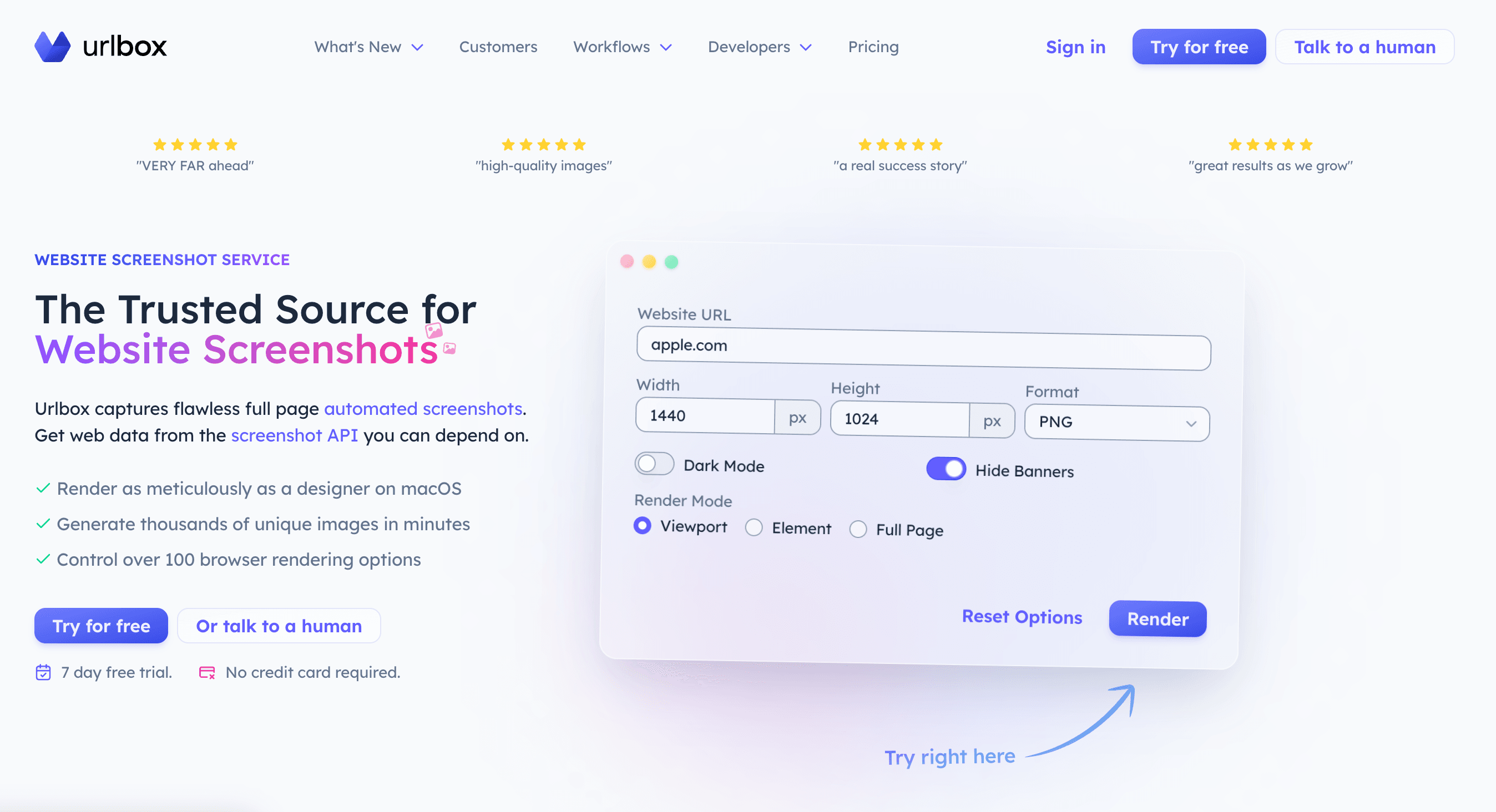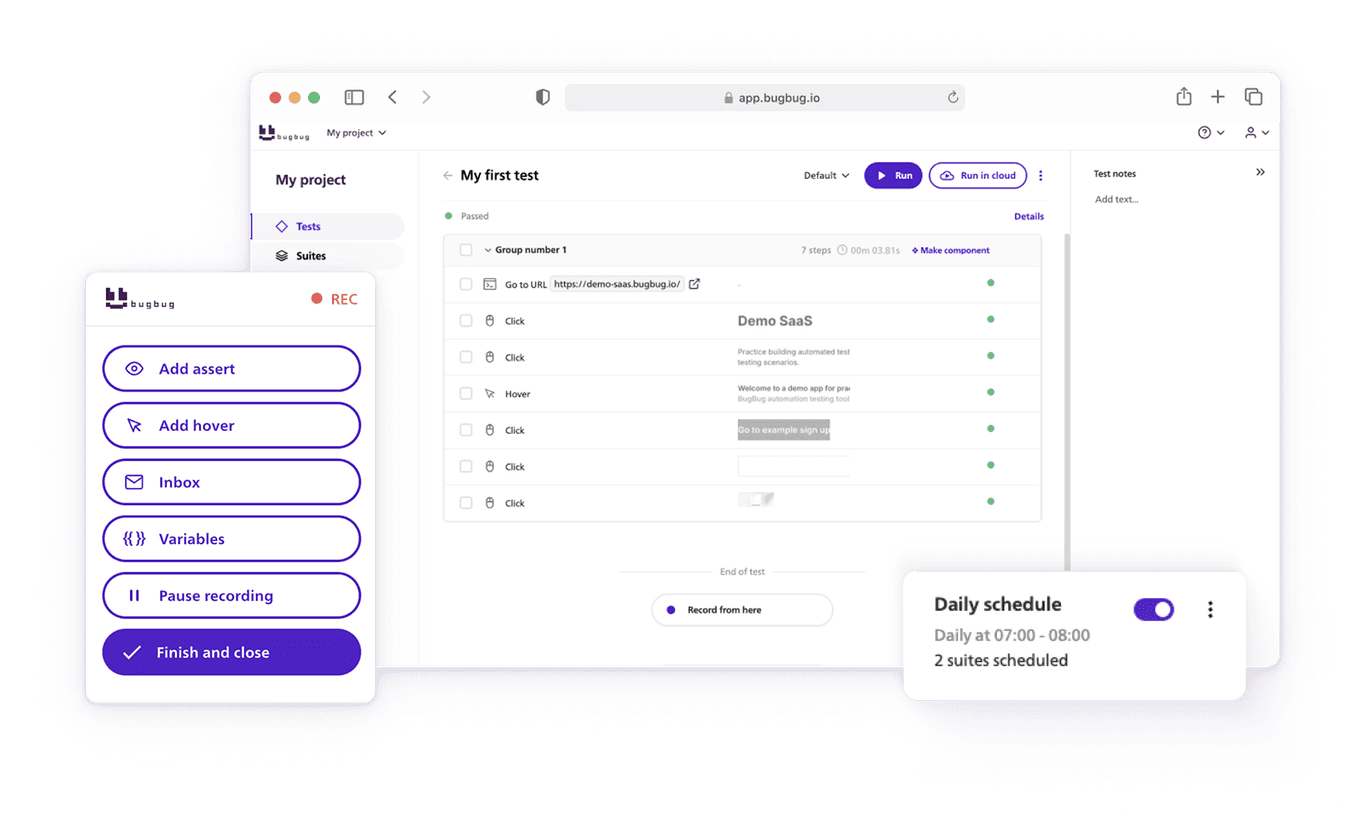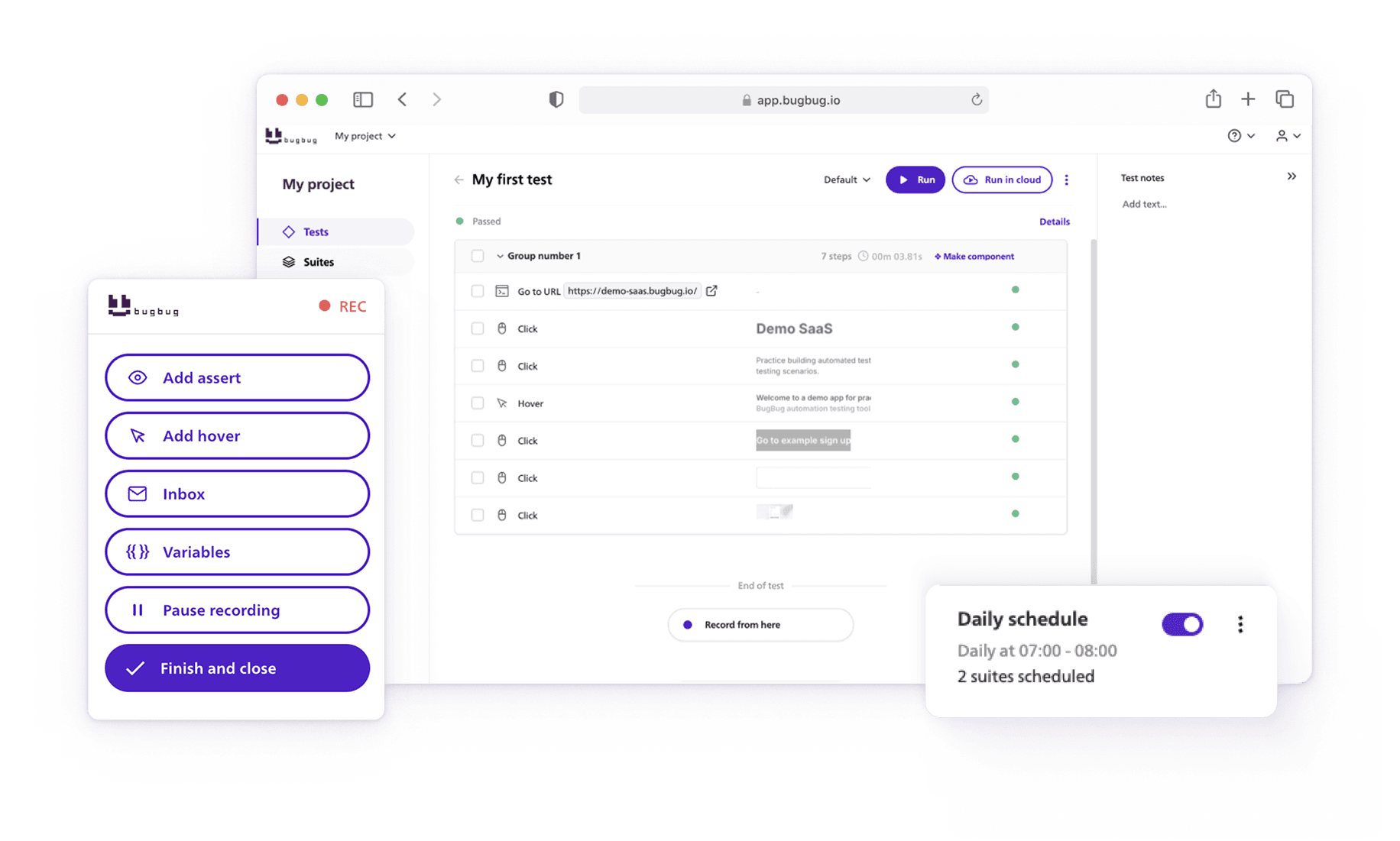When looking for the best alternatives to Puppeteer, there are several tools and frameworks you might consider, each offering different features that may be more suitable depending on your specific needs, such as ease of use, integration capabilities, and support for various programming languages.
Are you looking for a tool like Puppeteer but with a more straightforward setup?
We got you covered! Our in-depth comparison presents several options for desktop automation and open-source tools.
🎯 TL;DR - Puppeteer Alternatives
| Scenario | Best Choice | Why |
|---|---|---|
| Cross-browser E2E testing | Playwright, Selenium | Multi-engine support for Chromium, Firefox, WebKit |
| Codeless or low-code E2E | BugBug, Testsigma, Katalon, Testim, Endtest | Fast setup, visual editing, minimal maintenance |
| Dev-centric E2E in JS | Cypress, WebdriverIO, Nightwatch.js | JavaScript-native, great CI/CD integrations |
| Mobile app testing | Appium | Native/hybrid app automation on iOS and Android |
| Screenshot & PDF generation | Urlbox | Simple, scalable visual snapshots API |
| Real-device & cloud-scale testing | BrowserStack, LambdaTest | Cloud grids with thousands of browsers and devices |
Check also:
What Is Puppeteer?

When Puppeteer Is (and Isn’t) Enough
Puppeteer shines when you’re automating Chrome or Chromium tasks: taking screenshots, scraping content, or running headless UI tests. It’s lightweight and deeply integrated with Chrome DevTools.
But its main constraints are hard to ignore:
- Browser scope: Chromium-only (limited Firefox support, no Safari/WebKit).
- No native mobile testing: It can’t drive Android or iOS browsers directly.
- Developer focus: Requires JavaScript or TypeScript proficiency.
- Maintenance load: Managing flaky selectors and CI environments quickly becomes tedious.
If you’ve ever hit those roadblocks, the tools below will save you hours of frustration.
How to Choose the Right Alternative
Before picking, consider what type of testing you need:
- Browser coverage: Do you need Safari, Firefox, or just Chrome?
- Team skills: Is your team mostly developers, or do you need a codeless option for testers?
- Test types: Are you doing E2E UI flows, scraping, screenshots, or mobile?
- CI/CD scalability: Do you plan to run hundreds of tests in parallel?
- Maintenance: How easily can you fix broken tests? (Smart locators, auto-waits, or visual editing matter.)
- Budget: Open-source tools cost time; SaaS tools cost money but save maintenance hours.
If your tests are mostly visual or involve repetitive Chrome flows, a no-code tool like BugBug can replace complex Puppeteer scripts with point-and-click simplicity.
Top 10 Puppeteer Alternatives for 2025
BugBug
Best for web application testing with fast execution in Chrome

BugBug is a modern, visual web testing tool designed to simplify the process of creating and managing automated tests for web applications. It's a user-friendly, codeless platform that allows teams to automate their web testing efforts without needing deep technical skills in scripting or programming.
Key Features of BugBug:
👾 Codeless Test Creation: Enables users to create automated tests via a visual interface, making test automation accessible to non-developers.
👾 Visual Editor and Recorder: Provides a browser-extension test recorder that captures user interactions to facilitate test creation.
👾 Automatic Test Execution: Allows tests to be run automatically in the cloud or locally, ensuring flexibility in test deployment.
👾 Integration: Offers integrations with CI/CD pipelines and notification systems like Slack to streamline workflow.
💡 Check our guide on how Puppeteer Recorder compares to BugBug test recorder.
BugBug vs Puppeteer
| Feature | BugBug | Puppeteer |
|---|---|---|
| Best for | QA teams, non-technical testers, startups | Developers automating browser tasks through code |
| Ease of Use | Very easy, codeless UI | Requires JavaScript coding skills |
| Fixing Tests | Edit & Rewind, visual re-recording | Manual code updates |
| Smart Actions | Smart clicks & scroll | No |
| Test Runs | Unlimited (even in free plan) | Unlimited |
| Users | Unlimited | Unlimited |
| Pricing | Freemium, from $99/month | Free |
| Browsers Supported | Chromium | Chrome/Chromium, experimental Firefox |
| Integrations | CI/CD tools, PDF reports, JavaScript actions | CI/CD (via code), custom scripting |
💡 Check out the detailed comparison of BugBug vs. Puppeteer.
Strengths:
- Intuitive and codeless interface, perfect for testers with any skill level.
- Features like "Edit & Rewind" streamline debugging and reduce test maintenance time.
- Optimized for teams focusing on Chrome-based environments.
Best Use Cases:
- Teams requiring fast, codeless test automation tailored for Chromium.
- Projects focused on agile workflows needing rapid adjustments.
- Teams transitioning from manual testing with limited coding experience.
When Should You Choose BugBug Over Puppeteer?
- Simpler Learning Curve:
While Puppeteer requires JavaScript knowledge and manual scripting, BugBug’s no-code interface is designed for ease of use, allowing testers to create and debug tests without technical expertise. - Collaborative and Scalable:
BugBug supports unlimited users, projects, and test runs, making it ideal for teams scaling automation efforts without additional costs. - Transparent Pricing:
BugBug offers a freemium plan and affordable Pro options, whereas Puppeteer, although free, may require a significant investment in developer resources.
Get Started with BugBug Today
BugBug isn’t just a tool; it’s a smarter, simpler way to automate your testing processes. Whether you're a startup or an enterprise, BugBug adapts to your needs with features that eliminate manual effort and enhance reliability.
💡 Try BugBug’s Freemium plan today and automate your web application tests without spending a dime!
Testim
For agile teams requiring rapid test creation and maintenance, especially for end-to-end testing of dynamic web and mobile applications.

Testim leverages AI to stabilize tests and streamline the automation process, making it a strong choice for teams in fast-paced development environments.
Key Features:
- AI-Based Learning: Dynamically adjusts locators to ensure test stability even as applications evolve.
- Visual Test Creation: Enables users to create tests through an intuitive recording interface.
- Robust Integrations: Integrates seamlessly with CI/CD pipelines, issue trackers, and version control systems.
Strengths:
- Minimal maintenance for tests as applications change.
- Quick setup and ease of use with the visual interface.
- Comprehensive support for integrations.
Limitations:
- Primarily focused on web and mobile applications.
- Dependency on AI may result in less control for advanced testers.
Testsigma
For enterprises seeking a scalable, collaborative testing tool for web, mobile, and APIs, accessible to both technical and non-technical stakeholders.

Testsigma simplifies test automation by allowing natural language scripting and providing cloud-based execution across various platforms.
Key Features:
- Natural Language Processing: Write test cases in plain English for accessibility.
- Cloud-based Execution: Execute tests across diverse environments without additional setup.
- AI-Powered Insights: Identifies potential areas of failure and suggests test improvements.
Strengths:
- Suitable for cross-functional collaboration.
- Scalable for large projects across multiple platforms.
- Cloud infrastructure reduces operational overhead.
Limitations:
- May require additional effort to customize for complex test scenarios.
- Dependence on internet connectivity for cloud execution.
👉 Check also Top 10 Testsigma Alternatives
Katalon Studio
For teams requiring a versatile tool that supports API, web, mobile, and desktop application testing within a unified framework.

Katalon Studio provides an all-in-one platform for various testing needs with built-in templates and a rich plugin ecosystem.
Key Features:
- Comprehensive Testing Support: Unified framework for multiple testing modalities.
- Built-in Project Templates: Jump-start testing with customizable templates.
- Extensive Plugin Ecosystem: Enhances capabilities through a robust marketplace.
Strengths:
- Simplifies complex automation scenarios.
- Beginner-friendly with pre-configured templates.
- Versatile support for APIs, mobile, and desktop apps.
Limitations:
- May require a higher learning curve for non-technical users.
- Limited flexibility compared to custom-built frameworks.
👉 Check also Katalon Tool Alternatives
Endtest
For QA teams seeking easy-to-use codeless automation, particularly for smoke and regression testing across different regions.

Endtest offers a straightforward codeless automation platform with unique features like geolocation testing and video recordings for debugging.
Key Features:
- Codeless Test Automation: Simplifies test creation without scripting.
- Video Recording of Test Execution: Facilitates debugging and understanding test results.
- Geolocation Testing: Simulates different geographic testing conditions.
Strengths:
- User-friendly for non-technical testers.
- Effective for quick regression and smoke tests.
- Supports testing across varied regional setups.
Limitations:
- May not cater to highly complex testing scenarios.
- Limited extensibility compared to code-based frameworks.
Rainforest QA
For applications where human testing is essential, such as UX and exploratory testing, with quick turnaround times.

Rainforest QA combines crowdsourced human testing with an on-demand platform for rapid, insightful feedback.
Key Features:
- Crowdsourced Testing: Real human inputs enhance testing accuracy.
- On-Demand Platform: Offers quick test execution with fast result delivery.
- CI Integration: Ensures smooth integration with CI pipelines for continuous delivery.
Strengths:
- Ideal for UX and exploratory testing.
- Quick feedback loop from a global crowd of testers.
- No setup required for rapid deployment.
Limitations:
- Less suitable for repetitive or script-based testing.
- Dependency on external testers may limit control.
Cypress
For developers and QA engineers needing robust and fast testing for modern web applications, especially for unit and integration testing.

Cypress provides a developer-centric testing tool with real-time reloading, direct DOM access, and network traffic control for efficient test creation.
Key Features:
- Real-Time Reloads: Automatically reloads on test file changes.
- Direct DOM Access: Enables reliable and precise test writing.
- Network Traffic Control: Facilitates testing for API-driven applications.
Strengths:
- Fast feedback loop during development.
- Ideal for unit and integration testing.
- Developer-friendly with rich debugging tools.
Limitations:
- Limited to JavaScript/TypeScript for scripting.
- Primarily supports Chromium-based browsers.
BrowserStack - Cloud Device Labs & Scaling CI
For developers and QA teams who need to test the performance and functionality of apps across a wide range of real devices and browsers, particularly when accuracy is critical.

BrowserStack provides a comprehensive cloud-based platform for testing on real devices, enabling accurate, efficient testing of mobile and desktop applications.
Key Features:
- Real Device Cloud: Access a vast selection of real devices for thorough mobile and desktop testing.
- Integrations: Seamlessly connects with CI/CD pipelines and popular development tools.
- Local Testing: Enables secure testing of apps and websites hosted on local servers or behind firewalls.
- Automated and Live Testing: Offers tools for both automated and manual testing workflows.
Strengths:
- Accurate testing on real devices ensures reliability.
- Broad integration support streamlines development workflows.
- Flexible options for both automated and manual testing.
Limitations:
- Higher cost compared to open-source tools like Puppeteer.
- Limited control over test customization compared to code-based tools.
LambdaTest
For teams requiring extensive cross-browser testing across a vast array of browsers and platforms, with the scalability of cloud-based infrastructure.

LambdaTest is a robust cloud testing platform offering cross-browser compatibility testing with real-time and automated capabilities for seamless QA processes.
Key Features:
- Cross-Browser Testing: Ensures flawless performance across 2000+ browsers and their versions.
- Selenium Grid Online: Provides a cloud-based Selenium Grid for automated testing.
- Real-Time Testing: Enables live, interactive testing on desktop and mobile browsers.
- Integrations: Connects with project management and collaboration tools to enhance teamwork.
Strengths:
- Wide-ranging browser support for comprehensive compatibility testing.
- Cloud-based infrastructure eliminates the need for in-house servers.
- Interactive testing features facilitate debugging and troubleshooting.
Limitations:
- Dependency on internet connectivity for cloud execution.
- Learning curve for users unfamiliar with Selenium or similar tools.
Appium — Native, Hybrid, and Mobile Web
Appium is the industry standard for mobile test automation. It’s open-source, cross-platform, and supports native, hybrid, and mobile web apps across iOS, Android, and even Windows.
Key Features
- Cross-Platform Testing: Write one test and run it on both iOS and Android.
- Multiple Languages: Supports Java, Python, JS, C#, and Ruby.
- Real Device & Emulator Support: Run tests locally or via device clouds.
- Extensive Integrations: Works with Selenium Grid, BrowserStack, and cloud CI providers.
- Accessibility & Gestures: Automate swipes, taps, and hardware actions.
Strengths
- Mature ecosystem and strong community support.
- Reusable across web and mobile layers.
- Ideal for large mobile app teams or mixed stacks.
Limitations
- Steep learning curve for setup and driver configuration.
- Slower execution compared to browser-only frameworks.
Choose if: You need robust, cross-platform mobile automation and want full control over devices, emulators, and hybrid apps.
Urlbox — Reliable Visual Snapshots at Scale
Urlbox is a simple but powerful API for generating screenshots or PDFs from live web pages. Unlike full automation frameworks, it focuses purely on rendering accuracy and performance.

Key Features:
- Screenshot & PDF Generation: Capture full-page or viewport-level images.
- Custom Rendering Options: Configure viewport, device type, user agent, delay, and more.
- Cloud Infrastructure: No maintenance; scales automatically.
- Security Controls: Supports authenticated pages via headers, tokens, or cookies.
- Webhooks & Integrations: Automate pipelines for documentation, monitoring, or previews.
Strengths:
- Perfect for visual monitoring, SEO snapshots, and site previews.
- Fast and lightweight compared to browser automation libraries.
- Simple API makes it easy to integrate anywhere.
Limitations:
- Not a testing framework — lacks assertions and interaction logic.
- Paid usage for high-volume rendering.
Choose if: You only need reliable, on-demand screenshots or PDFs — not full E2E automation.
Code-First Frameworks (for Developers)
Playwright — “Puppeteer, Upgraded”
Developed by Microsoft, Playwright builds on Puppeteer’s API but expands it massively. It supports Chromium, Firefox, and WebKit—giving you true cross-browser testing with one script.
Pros
- Multi-browser and multi-context support
- Excellent tracing, screenshots, and debugging
- Stable cross-platform execution
Cons
- Slightly heavier setup
- Overkill for simple scraping
Choose if: You need reliable, parallel E2E testing across browsers with strong CI/CD support.
Selenium — The Veteran Standard
Selenium is the grandfather of web automation—and still a powerhouse. It works with all major browsers and supports languages like Java, Python, C#, and JavaScript.
Pros
- Unmatched browser coverage and community support
- Mature ecosystem of plugins and grids
Cons
- Slower setup; can be flaky without best practices
Choose if: You’re in an enterprise environment or need polyglot flexibility.
WebdriverIO — The Customizable JavaScript Runner
WebdriverIO offers a polished, developer-friendly way to run Selenium or DevTools-based tests. Its plugin system and clean syntax make it a favorite for JS teams.
Pros
- Rich plugin ecosystem and reporters
- Great CI integration
Cons
- Slightly slower than Puppeteer for simple headless runs
Choose if: You want a modern, configurable JavaScript-based E2E framework.
TestCafe — WebDriver-Free Simplicity
TestCafe skips the WebDriver layer entirely, running tests directly in real browsers. That means faster setup and less maintenance.
Pros
- Simple setup, concurrent browser tests
- Works across Chrome, Edge, Firefox, Safari
Cons
- Less control over browser internals than Puppeteer
Choose if: You need a stable, quick E2E tool without touching Selenium.
Nightwatch.js — Clean Runner on WebDriver
Nightwatch.js simplifies Selenium-based testing with an integrated test runner and built-in assertions.
Pros
- Straightforward syntax, easy CI/CD integration
- Multi-browser support
Cons
- Relies on Selenium drivers, slower to execute
Choose if: You want a unified JS + Selenium framework that’s easy to maintain.
Migration Paths from Puppeteer
If you want to stay code-first:
- Move to Playwright or WebdriverIO.
- Reuse your logic; add tracing and parallelization.
- Use robust selectors and built-in waits to reduce flakiness.
If you want to go codeless:
- Switch to BugBug.
- Record flows instead of scripting.
- Add validations visually and integrate with CI.
Quick migration checklist:
✅ Stabilize selectors and add timeouts
✅ Parallelize runs in CI
✅ Store test artifacts for debugging
✅ Continuously re-run critical flows
By carefully analyzing your project’s needs and comparing these 7 Puppeteer alternatives, you can select a tool that not only matches Puppeteer’s strengths but also addresses its weaknesses, ensuring a more efficient and reliable test automation process. Since Puppeteer is a widely adopted framework, these alternatives will help you test web applications effectively and navigate beyond its limitations.
Happy (automated) testing!



